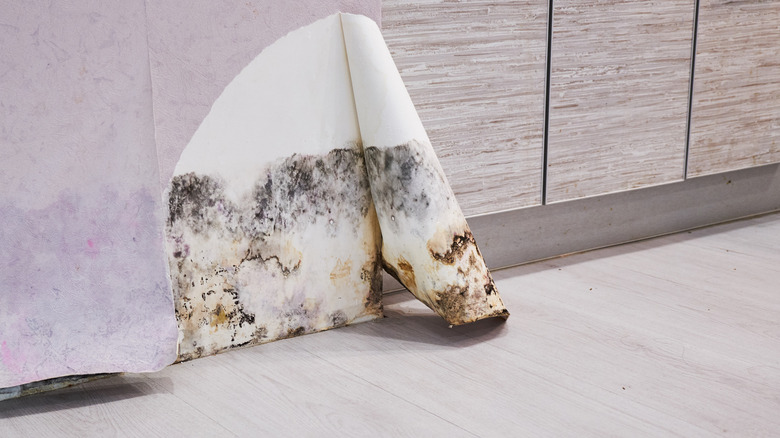What Causes Brown Stains On Your Wallpaper (And How To Prevent It)
Wallpaper adds an alluring pop of personality to any space, but without the proper care and attention, it can become an eyesore. If you've noticed an unsightly brown stain blooming on your beautiful wall coverings, you may be tempted to simply cover it up with wall art or a piece of furniture. However, this decision may come back to haunt you as it could be a sign of a bigger underlying issue, such as water damage or mold inside of your walls. It could also be an indicator that your wallpaper was improperly applied, or it may just be in desperate need of a good cleaning. Whatever the cause, don't fret because all of these issues can be addressed and prevented in the future with the proper steps.
There are many factors to consider when assessing the damage of your wallpaper stain. The wallpaper's material, color, and placement in your home makes stains more visible and likely to occur. For example, fabric wallpaper is less likely to develop mold, but it could become discolored if exposed to heat. Grasscloth is a luxurious and eco-friendly choice, but if it becomes stained, you may have a harder time cleaning it as it is not a washable wallpaper. For this reason, placing it in rooms with excess moisture such as bathrooms and kitchens could lead to disaster. Wallpaper in busy areas of your home, particularly in hallways and areas closer to the floor, will likely show signs of dirt and grime faster than other rooms. Let's dive into the potential causes of brown wallpaper stains and what you can do about it.
Potential causes of brown stains on wallpaper
A number of potential causes could be responsible for the brown stains on your wallpaper. Oftentimes, brown stains are a sign of water damage, which could also cause your wallpaper to peel, form bubbles, or develop a musty, mildewy smell. It may even be damp to the touch. Water damage typically occurs as a result of a leak and can be especially noticeable on light-colored wallpaper. If you suspect that this is the case, it is important to treat the issue quickly as it could be linked to more significant structural damage in your home. If the stain is accompanied by tiny black or brown specks, you may have a more serious problem on your hands: mold. Mold tends to sprout in rooms with excess moisture such as bathrooms, where poor ventilation and high humidity create optimal conditions for fungal spores to thrive.
If your wallpaper was recently applied, the cause of the stain is likely improper installation. Wallpaper that is poorly installed may show blemishes on its surface, either as a result of using too much paste or the wrong type of paste for your wallpaper. Though wallpapering is not difficult to do on your own, pulling it off successfully requires a good amount of research, preparation, and precision. The best way to prevent issues is to hire a professional. On the other hand, if your wallpaper is old, the cause of the stain could simply be buildup of dirt, grime, or grease. Wallpaper must be cleaned regularly, especially in high traffic areas, to keep it in good shape.
How to safely remove and prevent wallpaper stains
Once you've found the source of the stain, it's important to address it effectively to prevent it from coming back. If you suspect the culprit is water damage or mold growing inside your walls, you may have to remove a section of your wallpaper to see what's going on. For this, you will likely need to call a plumber or water damage restoration company to assess the issue. After the underlying cause has been addressed, add coat of waterproof primer on your walls before installing wallpaper. For added protection, choose wallpaper that is labeled as moisture resistant, such as vinyl.
Most surface stains on wallpaper can be washed away, but it's not as simple as grabbing your go-to household cleaner and scrubbing it off. Begin by dusting the wall to remove any surface debris or vacuuming with a handheld attachment if the wallpaper is fabric. Avoid using harsh chemicals, abrasive brushes, and excess water. Instead, create a solution with mild dish soap and warm water, and dab small amounts of the solution onto the mark with a microfiber cloth or sponge. For tougher stains, apply a solution of baking soda and water onto the area and wait a few minutes before washing it off. Most importantly, ensure that your wallpaper is washable before cleaning it. One of the top mistakes everyone makes when buying wallpaper is forgetting to check the washability rating before installing it. However, you can test the washability by applying some soapy water in an inconspicuous area. If the wallpaper reacts to the solution, then it cannot be washed.


